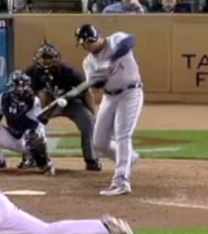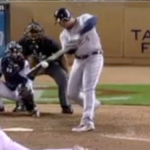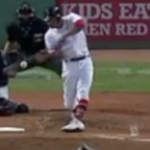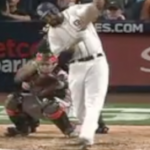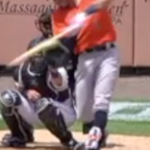“Pull your hands in”. “Just turn on it”. “Keep it fair”. These are all terms we have heard in regards to hitting the inside pitch with authority. They all have good meaning behind them and are helpful when used correctly. I want to break it down a bit more. Instead of just throwing out cues, we are going to look at what it takes to hit an inside pitch. We want to understand the what so we can then come up with our own unique how. Let’s get to it.
I first want to look at some stats related to hitting pitches in different zones. I retrieved all of the data via statcast search on baseball savant (baseballsavant.com). I used zones that indicated pitches either on the edge of the stikezone or off the plate. In other words, I used zones 11, 14, 17, 21, 24, 27, 13, 16, 19, 23, 26, and 29 on the representation below:
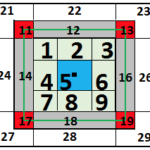
(credit goes to baseball savant for this visual)
I wanted to make sure I was evaluating tough pitches. I didn’t want them to just be inner/outer third, I wanted them on the edges. Pitches on the edges are harder to hit. If you can hit those, you can definitely hit something on the inner third. Anyway here are some of the numbers I came up with, from the 2016 MLB season:
BA for LHB on inside pitch: .222
BA for LHB on outside pitch: .270
BA for RHB on inside pitch: .239
BA for RHB on outside pitch: .255
*NOTE: these numbers only include balls that were put in play. In other words, I simply took the stat of balls in play, no out and divided that by balls in play, outs after adding the balls in play, no out to that total. Strikeouts, foul balls, etc were not taken into consideration. I tweeted about this a little bit before writing the article, but my numbers were off a tad. My apologies.
At first glance these numbers threw me off a bit. Left handed batters were hitting 17 points lower than righties on inside pitches?! Then I thought about it a bit and it made sense. The shift is obviously working. Sorry lefties. However, they make up for that by hitting the outside pitch at a substantially greater rate, 15 points higher than righties. In the end, these two basically even themselves out, the difference only being 2 points in batting average. That brings up a whole new question in regards to the success of the shift. After all, even though left handed batters hit the inside pitch the worst, it appears they get that pitch the least often, in fact almost half as much according to the numbers I got. I don’t know the reasoning behind this and will not cover it here as it is not in the scope of this article.
So we saw above that whether you are right handed or left handed, hitters hit the outside pitch at a higher clip than the inside pitch. I don’t think many of us would have guessed that would be the case. Pitchers are always taught to keep the ball outside if they want to stay out of trouble. These numbers just don’t seem to justify that. When we take a deeper look, we can get into why it may be harder for guys to square up balls on the inside edge.
Pitches that are thrown inside are often one of two types: Either the pitch is a fastball that is riding in on the hands, or the pitch is a breaking ball, often from an opposite handed pitcher, going for the hitters’ back foot. These pitches are not easy to hit. The fastball on the inner edge is the pitch in which the hitter has to be the quickest in getting to. The inside pitch requires the hitter to get it out in front a little bit further than any other pitch. Combine that with the fact that the fastball is the pitchers quickest pitch, and we see this is basically a test of the hitters swing efficiency. I.e how quickly the batter can launch his swing and get his barrel to the correct spot. The other pitch, the breaking ball going towards the hitters back foot, will often start right down the middle, pretending to be a fastball. It then darts down at the last second, evading the hitters barrel. This pitch requires superior pitch recognition to lay off of. So both of these pitches, for different reasons, are two of the toughest to handle. It is no wonder the batting average is lower. That brings us to the question: how can we get better at handling this pitch?
The first aspect is pitch recognition. This is something I don’t think we know nearly enough about yet. We know that the best hitters generally have the best eyesight. That’s great, but what if you don’t have great eyes? Is there anything you can do to makeup for that? Obviously, get glasses/contacts (or Lasik if you’re willing to drop some cash). This should help a quite a bit. After that, we can use different things to challenge your vision. Hit with one eye covered, take video of pitchers and cut it off right at ball release. You should be able to tell what pitch it is right at that moment. (If you are an Apple user, Gamesense has a great app for this. I highly recommend it). A couple different companies sell goggles that obstruct your vision. All of these things will probably be helpful in helping you recognize pitches better. Get on them.
The second aspect of this equation is the swing itself. As I already stated, the inside pitch is the one that requires the most swing efficiency. If you cannot launch quickly, you have no shot. Lets take a look at some successful, and some unsuccessful swings on inside pitches:
Mookie Betts HR inside pitch:
And one more. Miguel Cabrera HR on an inside pitch:
Both of these pitches were absurdly far inside to be hit out of the ballpark. Now lets look at two unsuccessful swings on inside pitches.
And one more:
The first thing I want to do is get to contact of each of these swings. We can work backward from there. First the two HR’s:
Here is Miggy:
So they are all at similar positions at contact. The one that stands out to me is Kemp. His shoulder angle seems to be a tad bit more downhill than the others. Now, his pitch was also a little lower than the other ones so that will explain some of that. However, I also got a different feel when watching the swing he took. It looks like he pulled off just a hair. And yes, I know “pulling off the ball” is one of those catch phrases everyone throws around so let me explain. First, two clips slowed down of the frames up to and through contact:
Miggy:
Kemp:
Watch both of their heads and front shoulders. With Miggy, we see everything stay quiet. That allows the barrel to continue its path without getting yanked off course. Kemp does not stay as quiet. His head moves a tad downward and his front shoulder yanks to the left. Everything your body does will have an effect on the bat, and ultimately the barrel, which is really what we are concerned about here. So if Kemp feels like he needs to yank to the left even a little bit, that is going to affect the path his barrel is on. Try this. Stand up and get a broomstick, or really anything that is straight and is long enough to be on the ground but still reach up to your armpit region. Now, line it up with your back foot and grab it with your left hand if you’re a righty and right hand if you’re a lefty. Now, without allowing your hand on the broomstick to come forward, turn your torso to the left if you’re a righty and vice versa if you’re a lefty. What happens to your front arm? It straightens out, right? When your arm is straight it is farther away from your body. That doesn’t bode well for hitting the inside pitch! So when Kemp feels that little bit of need to yank left to hit this particular inside pitch, he is not going to be able to get his barrel there.
Correa’s case is a little bit different. I didn’t see him yank like Kemp did. Remember when I said there were two parts? The swing and the vision part? Correa executed a pretty good swing on the pitch he got. However it was so far up and in there wasn’t much he could do with it from the start, besides not swing at it. There is rarely one answer for everything. It always depends on the situation.
So a quick review. To hit this pitch successfully we need to:
-see it correctly out of the hand (true for every pitch)
-be quick/short to the ball (in this context “short” means what Cabrera did, long means what Kemp did)
That wraps up this mammoth post on hitting the inside pitch. If things weren’t clear enough or you still have questions, don’t be afraid to ask!
